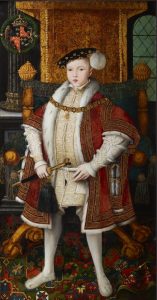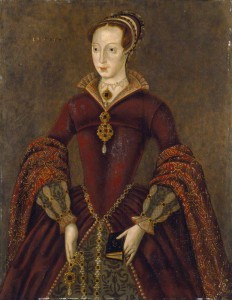6th July marks the 467th anniversary of the death of King Edward VI. By bequeathing the crown to Jane, Edward set in motion the dramatic events of July 1553, ‘when in the space of 24 hours, the country had two rival queens regnant’ (1) and resulted in Jane’s execution in February 1554.
Apart from the ‘Devise for the succession’ what other evidence is there of the relationship between Edward and Jane, who were first cousins once removed? Were they born in the same month? Were there plans for them to marry? Is there any record of their mentioning the other or their being together at court?
Prince Edward was born at Hampton Court Palace on 12th October 1537. Various Victorian and Edwardian writers had Jane’s birth taking place in the same month as Edward. Agnes Strickland wrote that Jane ‘was herself born in October 1537, very nearly at the same time as her royal cousin Prince Edward.’ (2) Richard Davey had Jane born ‘in October 1537, most probably in the first days of the month, for Prince Edward, her cousin, came into this world on the 12th.’ (3) Jane’s date of birth was not recorded but research by Dr Stephan Edwards has placed her birth in late 1536. (4)
According to the terms of Henry VIII’s will in January 1547, Jane was fourth in line to the throne. Henry’s promotion of the descendants of his youngest sister Mary, over those of his sister Margaret, dramatically increased Jane’s importance.
In 1548, Jane became the ward of Sir Thomas Seymour (uncle to King Edward). One of the promises, he allegedly made to Jane’s parents was the possibility of Jane’s marriage to the King. After Seymour’s arrest for treason in March 1549, Jane’s father was questioned by the Privy Council. Henry Grey stated that one of the reasons he was persuaded to let Jane return to Seymour’s house after the death of the Dowager Queen, Katherine Parr, was: ‘that he wold mary hir to the King’s Majestie; saying ferther, that if he might get the King at Libertie he durst warrant the said Lord Marques, that the King shuld mary his said Daughter.’ (5)
Seymour’s servant, Harington, who had visited Henry on Seymour’s behalf, gave the following evidence under examination: ‘for so mych he had heard the Lord Adnyrall not plainely speake it, but cast out such Words that he might perceive his Meanyng; as speakying of the said Lady Jane, “That she was as handsom a Lady as eny in England, and “that she might be Wife to eny Prince in Chrstendom, and that, if the King’s Majestie, when he came to Age, wold mary within the Realme, it was lykely he wold be there, as in eny other Place, and he wold with it.’ (6)
Among the religious men supported by Jane’s father was John of Ulm, who wrote to Heinrich Bullinger, ‘A report has prevailed and has begun to be talked of by persons of consequence, that this most noble virgin is to be betrothed and given in marriage to the King’s Majesty.’ (7). He also wrote to Conrad Pellican that Jane ‘is to be married, as I hear, to the king. (8)
While Jane’s marriage to the King was an ambition of Seymour and Jane’s parents, there is no evidence that Edward viewed his cousin as a potential bride. Edward had been betrothed to Mary, Queen of Scots under the terms of the 1543 Treaty of Greenwich. However, in 1548 Mary was sent to live at the French court as the future bride of the Dauphin.
Another possible bride for Edward was the French Princess, Elizabeth of Valois. The young king wrote in his diary on 21 May 1551 that the Marquis of Northampton had been ‘commissioned to deliver the Order of the Garter and to treat in all things, chiefly the marriage to me of his daughter the Lady Elizabeth.’ (9) Edward later wrote that his future bride, ‘should be brought at her father’s expense three months before she was 12, sufficiently jewelled and stuffed.’ (10) The marriage was off by March 1552, when, as de Lisle writes, ‘Edward had formally declined to ally against the Emperor, Charles V. (11)
When Jane married Guildford Dudley on 25th May 1553, Edward was too ill to attend but the Spanish Ambassador had reported to the Emperor on the 12th May, that ‘the King has sent presents of rich ornaments and jewels to the bride.’ (12)
Edward’s only known mention of Jane, other in relation to her marriage to Guildford or making her his heir, is in relation to the visit of Mary of Guise. On 4th November 1551, Edward entertained Mary of Guise at the Palace of Westminster. Noting afterwards in his diary that:
‘The Duke of Suffolk and the Lord Fitzwalter, the Lord Braye and many other lords and gentlemen accompanied by Suffolk’s wife, the Lady Frances, the Lady Margaret [Douglas], the Duchess of Richmond and of Northumberland, the Lady Jane, daughter to the Duke of Suffolk, the marchionesses of Northampton and Winchester, the countesses of Arundel, Bedford, Huntingdon and Rutland, with 100 other ladies and gentlewomen, went to the dowager and brought her through London to Westminster.’ (13).
The only evidence of Jane mentioning Edward is in her letter to Queen Mary, written whilst a prisoner in the Tower. According to Jane, on learning of Edward’s death and that she was Queen, those at Syon, ‘saw me fall to the ground weeping bitterly, and afterwards avowing my own inadequacy I deeply grieved over the death of such a noble Prince.’ (14)
We know from Edward’s diary that he and Jane were at court together on 4th November 1551. The previous month Henry Grey had been made Duke of Suffolk. The Wriothesley Chronicle recorded, ‘Memorandum: the xi th daie of October was a great solemnitie kept at the Kinges Maiesties Court at Hampton Court, where that daie Lord Gray, d Marques Dorsett, was created Duke of Suffolke;’ (15)
Although as de Lisle writes, the November visit of Mary of Guise, ‘apart from the funeral of Catherine Parr…(was) the first time we know of Jane being present at a public reception, (16) it seems entirely possible that Jane was there at the ceremony but that the fact was not recorded. Nicola Tallis writes of Mary of Guise’s visit that, ‘this may have been one of a series of appearances that Jane made at court, for Roger Ascham later observed that ‘at court I was very friendly with her.’ (17)
Sources
1.Porter, L. (2007) Mary Tudor: The First Queen, Piatkus Books, p. 196
2.Strickland, A. (1868) Lives of the Tudor Princesses, including Lady Jane Gray and Her Sisters, p.96. https://play.google.com/books/reader?id=3zq10ofh7A4C&hl=en_GB&pg=GBS.PA94
[Date accessed: 27 June 2020]
3.Davey, R. (1909) The Nine Days’ Queen: Lady Jane and Her Times, Methuen & Co, p.14. https://archive.org/details/ninedaysqueenlad00daveuoft/page/14/mode/2up [Date accessed: 27 June 2020]
4.Edwards, J.S (2016) The Lady Jane Grey’s Prayer Book: British Library Harley Manuscript 2342, Fully Illustrated and Transcribed, Old John Publishing, p.21.
5.Haynes, S. (1740) A Collection of State Papers relating to Affairs In the Reigns of King Henry VIII, King Edward VI, Queen Mary and Queen Elizabeth: From the year 1542 to 1570, Bowyer, p.76. https://play.google.com/books/reader?id=YitDAAAAcAAJ&hl=en_GB&pg=GBS.PA76 [Date accessed 28 June 2020]
6.Ibid, p. 83.
7.De Lisle, L. (2010) The Sisters Who Would Be Queen: The Tragedy of Mary, Katherine and Lady Jane Grey, HarperPress, p.73
8.Robinson, H. (ed) (1847) Original Letters Relative to the English Reformation, Written During the Reigns of King Henry VIII, King Edward VI, and Queen Mary. Vol. 2, Cambridge The University Press, p.432.
9.North, J. (ed) (2005) England’s Boy King: The Diary of King Edward VI, 1547-1553, Ravenhall Books, p.86.
10.Ibid, p.91.
11.De Lisle, L. (2010) The Sisters Who Would Be Queen: The Tragedy of Mary, Katherine and Lady Jane Grey, HarperPress, p.89.
12.’Spain: May 1553′, in Calendar of State Papers, Spain, Volume 11, 1553, ed. Royall Tyler (London, 1916), pp. 37-48. British History Online http://www.british-history.ac.uk/cal-state-papers/spain/vol11/pp37-48 [accessed 29 June 2020]
13.North, J. (ed) (2005) England’s Boy King: The Diary of King Edward VI, 1547-1553, Ravenhall Books, p.115.
14.Malfatti, C.V (translator) (1956), The Accession Coronation and Marriage of Mary Tudor as related in four manuscripts of the Escorial, Barcelona, p.48
15.Wriothesley, C. (1877), A Chronicle of England During the Reigns of the Tudors, Vol II, p.56. https://archive.org/stream/chronicleofengla02camduoft/chronicleofengla02camduoft_djvu.txt [Date accessed 3rd July 2020]
16.De Lisle, L. (2010) The Sisters Who Would Be Queen: The Tragedy of Mary, Katherine and Lady Jane Grey, HarperPress, p.81.
17.Tallis, N. (2017) Crown of Blood: The Deadly Inheritance of Lady Jane Grey, Michael O’Mara Books Ltd, p.118.



































